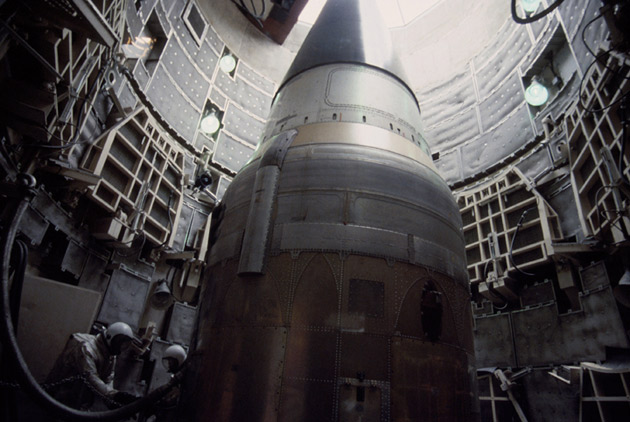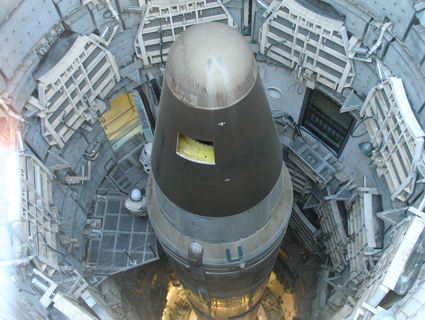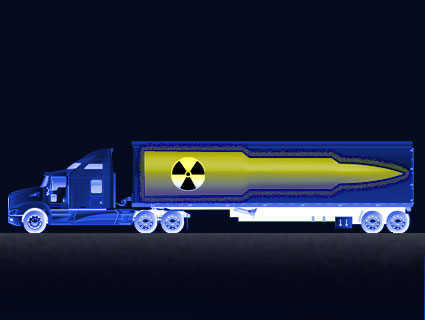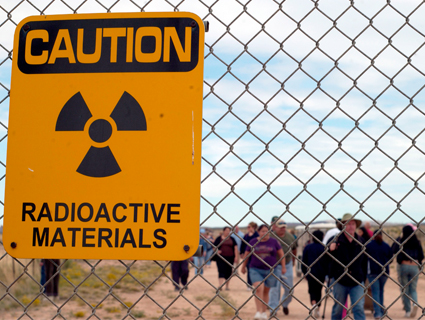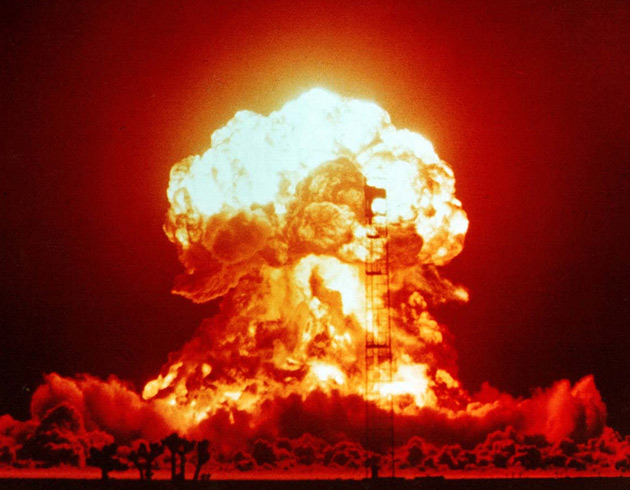
A 1953 detonation of the 23 kiloton XX-34 Badger at the Nevada Test Site.Official CTBTO Photostream/Flickr Creative Commons
The term “wake-up call” is a tired cliché, but it is appropriate in the case of Command and Control, the frightening new exposé of America’s nuclear weapons mishaps by Fast Food Nation author Eric Schlosser. (Click here to read an excerpt and my detailed review.) In short, Schlosser delivers a book full of revelations that left me agape. While we still worry in the abstract about Iran and North Korea and Pakistan, it’s easy to forget that we still have thousands of our own ungodly devices on hair-trigger alert at this very moment. And even if we never drop or launch another nuke on purpose, these weapons are, in his words, “the most dangerous machines ever invented. And like every machine, sometimes they go wrong.”
That’s what the book is about. Through hard-fought documents and deep digging and extensive interviews, Schlosser reveals how close we’ve come, on numerous occasions, to a domestic nuclear detonation or an accidental war in which there are only losers. Command and Control will leave many readers with a deep unease about America’s ability to handle our nukes safely. Schlosser’s hope is that this unease will beget a long-neglected debate about “why we have them and when we use them and how many we need.” But his book is no screed. He delivers an engrossing page-turner. Would that it were fiction.
Mother Jones: The safety of America’s nuclear arsenal is far cry from fast food. What got you interested in this topic?
Eric Schlosser: I spent some time with the Air Force before Fast Food Nation came out. I was interested in the future of warfare in space: space weapons, particle-beam weapons, lasers, directed-energy devices. A lot of the people who were involved in it had started their careers as missile-crew officers. As I spent time with them, I became more interested in their stories from the Cold War about nuclear weapons than I did in the future of warfare in space.
MJ: How long did it take to research the book?
ES: A lot longer than I thought it would. I originally was going to write a relatively short book about this accident in Damascus, Arkansas, which was an extraordinary story. But the deeper I got, the more I realized that the subject of nuclear weapons accidents hadn’t really been written about, and that the threat was much greater than I thought it was. So what started out as a two-year project turned into six—and an extraordinary amount of digging around in strange places.

MJ: My general takeaway is that, given our history of near misses, it’s essentially dumb luck that we haven’t had an accidental nuclear detonation on American soil, or an accidental launch.
ES: If we don’t greatly reduce the number of nuclear weapons in the world, or completely eliminate them, a major city is going to be destroyed by a nuclear weapon. It’s remarkable—it’s incredible!—that a major city hasn’t been destroyed since Nagasaki. We can confront this problem or we can accept that hundreds of thousands or more will be killed. And I don’t think that’s inevitable. The book was really written with a notion of trying to prevent that.
MJ: But is it inevitable if we maintain our current course?
ES: My background, academically, is history. I hate the word “inevitable” because I feel like things don’t have to be the way they are. But we really need to change our policies. I think Obama has done a terrific job of trying to raise awareness about nuclear weapons. But we really need to sit down with Russia, China, England, France, India, Pakistan, and think about how to greatly reduce, if not eliminate, these weapons. And that may sound totally absurd and unrealistic, but when I was in my 20s, if someone had said that the Soviet Union would vanish without a nuclear war and the Berlin Wall would come down and all this would happen without tens of thousands, or millions, of deaths, people would have thought that was absurd.
MJ: What do you think might befall our society were an accidental detonation to occur? I mean, suppose that H-bomb had exploded in North Carolina?
ES: It would have profoundly shocked this country and the world. When you look back at the response after Hiroshima and Nagasaki, that was around the period that the United Nations was nominally created, and support for eliminating nuclear weapons was not only in the air, but was embraced by the majority of Americans. As the decades passed, particularly since the Second World War, we lost the sense of how devastating these weapons can be—and also what its like to be in a society that’s been completely destroyed by warfare. We’re very fortunate in the United States that we’ve been protected by geography. I was in Manhattan on 9/11, and the difference between having 3,000 Americans killed, which was horrible on 9/11, versus 500,000 or a million is almost impossible to comprehend. These weapons are machines, and I think they are the most dangerous machines ever invented. And like every machine, sometimes they go wrong.
MJ: I find it remarkable how little public attention has been paid to the safety of nuclear weapons since the end of the Cold War.
ES: I can’t really blame the media. The government—lying might be too strong a word, although in some instances they absolutely lied about it—but they did everything they could to cover up these accidents, to distract attention from them, and when attention was paid to them, in most cases, to mislead the press.
MJ: Some examples?
ES: Throughout the ’50s and ’60s, it was almost boilerplate for Defense Department officials to say that during an accident there was no possibility of a nuclear detonation, while privately, at the weapons laboratories, there were physicists and engineers who were extremely worried and were well aware that we had come close to having it happen on American soil. If you look at the official list of broken arrows that the Pentagon released in the ’80s, it includes 32 serious accidents involving nuclear weapons that might have threatened the public safety. The list is entirely arbitrary: Some of those accidents didn’t even involve weapons that had a nuclear core, so they never could have detonated. But many, many serious accidents aren’t on that list.
One document I got through a Freedom of Information Act request listed more than 1,000 weapons involved in accidents, some of them trivial and some of them not trivial. There’s somebody who worked at the Pentagon who has read this book, and one of his criticisms was that I’m so hard on the Air Force—he said that there were a great number of accidents involving Army weapons that I don’t write about.
You know, it’s very difficult to get this information. I did the best that I could, but I have no doubt that there are other incidents and accidents that still have not been reported, so I can’t blame the mainstream media so much as blame this national security apparatus. Again and again I would see by comparing documents that what was being redacted wasn’t information that would threaten the national security—it was information that would be embarrassing, or put these defense bureaucracies in an unflattering light.
MJ: Were you surprised the Air Force gave you as much as it did?
ES: The Air Force was remarkably unhelpful. I was able to get what I got through FOIA requests to the Department of Energy and the Pentagon—some of these things took a couple of years, and some of them were heavily excised. We’re talking about a nation that no longer exists, the Soviet Union. We’re talking about weapons that are no longer in the stockpile. And yet when you get these documents, it’s remarkable how much has been blacked out. The thing that was enormously helpful to me, and surprising, was to find that some of the most anti-nuclear people in the US are the people who designed, handled, had command of these weapons.
MJ: When most people think of nukes, we think of these massive, high-yield bombs, but you also write about nuclear artillery shells, nuclear depth charges, and even a nuclear rifle called the Davy Crockett. How is it even possible, given the institutional dysfunction of the military, to maintain tight control with all these small nukes around?
ES: It was a constant challenge, and particularly when these weapons were being stored in Europe for use against an invading Red Army, it was a matter of inventory control. This book is critical of the management of our nuclear weapons, and yet the Pentagon deserves its due: To my knowledge, there was never an accidental detonation. If you add them all up, we probably made 70,000 of these things. If one of them had detonated, it means 69,999 did not. And that’s very good management. But still, the consequences of one detonation are almost unimaginable.
MJ: You can’t screw up!
ES: You can’t screw up once! And that’s the unique danger of these machines. The incident in 2007, when we lost half a dozen hydrogen bombs for a day and a half, was an incredibly serious security lapse: The fact that nobody was asked to sign for the weapons when they were removed from the bunker, the fact that nobody in the loading crew or on the airplane even knew that the plane was carrying nuclear weapons is just remarkable.
MJ: And this was six years ago!
ES: Yes. And the Air Force seems still not to have gotten its act together. There was a decertification of launch crews at Malmstrom Air Force Base, one of our three Minuteman bases, just a few weeks ago. There was a decertification at Kirtland Air Force Base in New Mexico, which is where the Air Force stores most of its nuclear weapons.
MJ: What’s a decertification?
ES: It means they’re failing their safety inspections. This is very, very serious stuff. The margin for error is as small as can be.
MJ: In the book, you relate how Harold Agnew, a Los Alamos physicist visiting a German base in 1960, “nearly wets his pants” when he saw planes with fully assembled H-bombs being guarded by lone US soldiers who weren’t even trained in what to do if someone tried to commandeer the plane. I can’t imagine that we’re still so careless.
ES: What was remarkable then was that we were sharing these weapons with our NATO allies. In that case, he saw a powerful nuclear weapon loaded onto a jet that was part of the German air force and had the Iron Cross markings on its wings. His concern—this wasn’t so long after the end of World War II—was that a disgruntled German pilot might just take off, head for Russia, drop his bomb, and there was absolutely nothing except for the air defense system of the Soviet Union to prevent him from doing that. There were no locks on the bombs. There were no codes required to activate the bomb. It was in the early days of the Kennedy administration that there was a crash program begun to do something you’d think common sense would dictate, which would be: Put locks on the nuclear weapons, and put coded switches on them so only the person who has the code could set them off. But there was a learning curve in the management of nuclear weapons, and we are very, very lucky. And there’s no guarantee that luck will last.
MJ: Describe the reaction of Sandia weapons safety expert Bob Peurifoy when you showed him the list of broken arrows you obtained through FOIA requests.
ES: I think Peurifoy is a national hero. He was a weapons designer at the lab who became concerned about safety and fought for 20 years to get modern safety devices installed on our nuclear weapons, at great personal cost. He knew as much about nuclear weapons accidents as any person in our national security establishment. There was a document I got listing accidents and less-serious nuclear incidents, and I gave him a copy to see what he thought of it. And he was stunned and very depressed by it, because it was clear that there were many incidents that were not being shared with him.
There was an enormous amount of compartmentalized secrecy, and that was to prevent secrets from being too widely shared and potentially leaked. But what that meant was people in different parts of the system didn’t have an overall view of how the system was operating—and that can be very dangerous. The people designing the weapons literally often didn’t know how they were being handled in the field by the Air Force—and a lot of people in the Air Force didn’t understand some of the dangers. There’s a very strong element of madness in this.
MJ: One of the Peurifoy’s greatest challenges was this constant tug-of-war between the desire to deploy a weapon quickly and the desire to have it not go off accidentally. The military invariably erred on the side of speed. Has that balance changed since the end of the Cold War?
ES: It hasn’t. There’s always going to be that inherent tension when you have these conflicting design goals. They can be expressed by the phrase “always/never.” The things that would ensure the weapon always works flawlessly may conflict with the things that make sure it never goes off accidentally, never gets stolen, never gets sabotaged.
This is especially important when you want your nuclear weapons available for immediate use, as we do in the United States. Right now, our land-based missiles are ready to be launched pretty much within a minute or so. To keep these WMDs on a trigger like that means that you’re adding an element of danger, a chance of accidental launch—whereas if you, for example, were to take the warheads off the missiles and not have them available for immediate use, they would be considerably safer. We still have the capability, if we get a signal that China or Russia has attacked the United States, to launch our missiles before they’re destroyed by these incoming weapons. But that means you’ve got to really make sure the radar signals are the right ones.
MJ: And you haven’t much time, especially with a submarine launch.
ES: Yeah, the time between when you see them on the radar and when they might hit might be six, seven, eight minutes if the sub is off the coast of the United States.
MJ: You describe a bunch of WarGames-type incidents during which this really happened—we got false launch signals or the Russians got false signals.
ES: There were two major false alarms during the Carter administration. One of them occurred when a training tape was accidentally put into the computer at NORAD that was supposed to warn us of a Soviet attack. It was a very realistic simulation of a Soviet attack, and so that created a great deal of concern until it was realized that it was a false alarm. Not that long afterward, during the tense period after the Soviets had invaded Afghanistan, there was a computer error at NORAD that basically said that more than 1,000 missiles were on their way. National Security Advisor Zbigniew Brzezinski was woken up in the middle of the night and told that it looked like the US was under attack. He waited for more confirmation before calling the president, but he was fully prepared for this nuclear strike and to order a counter-attack. According to Bob Gates, who was head of the CIA and later Secretary of Defense, Brzezinski deliberately didn’t wake his wife, because if they were all going to die, he just wanted it to happen while she was sleeping. Having a launch-on-warning capability like we do, and having our missiles on alert is a very dangerous game, because once one of our missiles is launched—unlike bombers—there’s no calling it back.
MJ: In the early days of nuclear weapons, the authority to launch was solely in the hands of the president, and that got diluted. How many people have that authority now?
ES: Good question, and that’s probably very top secret. What happened was, as there was a great realization that Washington could be destroyed by the Soviets with little or no warning, there was a need to delegate the presidential authority so that if the president were killed, the United States could mount a retaliation. But once you start delegating authority—essentially sharing the launch codes—you introduce the possibility that somebody could start using our weapons without the authorization of the president. And this was particularly of concern with NATO, because it’s clear that the supreme allied commander in Europe had been delegated the authority to use nuclear weapons; if there was a communications breakdown between the United States and Europe, the NATO officers on their own could initiate the use of nuclear weapons, and things could spiral completely out of control very quickly. It’s not clear to me who is delegated to authorize their use today.
MJ: NATO no longer has that authority?
ES: NATO doesn’t really have nuclear weapons on alert anymore—there are some delegated to NATO through submarines, and there are maybe 200 tactical nuclear bombs, but they’re not mounted on airplanes.
MJ: Your book’s central narrative involves the deadly explosion you mentioned, which took place at a Titan II missile silo in Arkansas in 1980. What were the key lessons of that disaster, and do you think the military has learned them?
ES: I’m quite concerned. One of the lessons would be, if you’re going to have nuclear weapons, you must spare no expense in the proper maintenance of them. The Titan II was widely regarded as obsolete. They were running out of spare parts. There were frequent leaks, and the warhead was acknowledged not to have adequate safety devices. The people working on it were often poorly trained, poorly paid, overworked. There were shortages of trained technicians. In retrospect, it was completely irresponsible to have all of those things occurring with a missile carrying the most powerful warhead ever put on an Air Force missile. It’s just extraordinary! And there were high rates of drug use. I spoke to people who had been involved in sensitive nuclear positions who were smoking pot at the time. You don’t want people smoking pot and handling nuclear weapons. So those are some of the crucial takeaways. And yet our land-based missile, the Minuteman III, is upward of 40 years old. The B-52 bomber hasn’t been manufactured since John F. Kennedy was president, and some of those bombers are getting close to 65 years old. We really should either invest in our weapons systems or get rid of them.
Look at what happened with the Air Force, starting with that 2007 incident when they lost those hydrogen bombs. A few years ago, they lost communication with an entire squadron of Minutemen missiles—50 missiles!—for almost an hour. They had to decertify the maintenance crew that looks after the biggest Air Force storage facility in New Mexico. Seventeen launch officers were taken off duty earlier this year for safety violations. There’s a sense of a lack of direction, and mismanagement right now—particularly in the Air Force. And it’s intolerable. It’s unacceptable.
MJ: Obviously, the warhead on that Titan II didn’t detonate. But even barring a nuclear explosion, should we be worried about a dirty-bomb type scenario where, say, plutonium is dispersed over a populated area?
ES: Yes. That warhead didn’t contain plutonium, but the warheads on top of our Trident II missiles do. They are mounted around the third stage of the missile in a way so that if the rocket fuel were to detonate, you could have a major scattering—and that’s still a major issue with our Trident bases in Washington state and in Georgia. You have to be extremely careful about how these warheads are mounted on the missiles and how the missiles are put in the submarines. These are dangerous devices. And I’m not the first person to say that. I know that the Navy is quite aware of it, but I don’t think the general public is.
In college, I studied game theory and nuclear strategy, and I was interested in the nuclear freeze movement, so I read an enormous amount about nuclear weapons. But doing this book, I realized that my ignorance was profound. And this is important knowledge for American citizens to have, because we need to have a meaningful debate about nuclear weapons, about nuclear strategy, and why we have them and when we use them and how many we need. That’s pretty much why I wrote the book.
MJ: Curtis LeMay, who ran the Strategic Air Command back in the day, was almost this kind of caricature of a military hawk. On the other hand, it seems like America’s nuclear weapons were under far tighter control on his watch.
ES: Yeah. LeMay at one point was considered a great American hero, protecting us from the Soviets. He later became widely reviled in the United States, the symbol of a warmongering general who was caricatured in Dr. Strangelove as the mad general played by George C. Scott. LeMay’s politics are different from mine, and many of his theories of nuclear warfare are ones that I don’t endorse, but I think he was one of our truly great generals. He was an engineer by training, and if you’re going to have nuclear weapons, you want them managed by someone who has absolutely no tolerance for error, who’s a great believer in checklists and proper organization. He was all of those things. LeMay was absolutely ruthless with his men about ensuring that there was no sloppiness.
The other thing I think made him a great general was that he was brave and willing to take risks himself. During the Second World War, he flew the lead plane during some dangerous bombing missions just to show his men that the plan was a sound one. He was the sort of commander that’s more and more sort of missing in America.
With this nuclear weapon accident in Arkansas, there was a remarkable lack of accountability. The people who were held responsible and punished for it were the low-level enlisted men, and not some of the high-ranking officers and generals who had made the crucial decisions that contributed to the disaster. So, LeMay certainly made mistakes, but if you look at how our nuclear weapons are being managed now, we could use a little bit more of Curtis LeMay.

